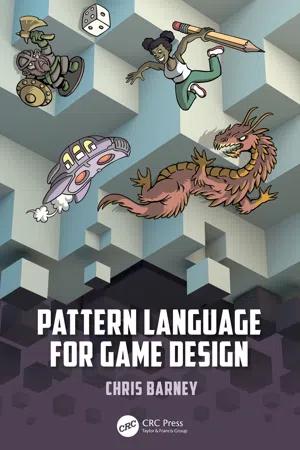
- 476 pages
- English
- ePUB (mobile friendly)
- Available on iOS & Android
Pattern Language for Game Design
About this book
Chris Barney's Pattern Language for Game Design builds on the revolutionary work of architect Christopher Alexander to show students, teachers, and game development professionals how to derive best practices in all aspects of game design. Using a series of practical, rigorous exercises, designers can observe and analyze the failures and successes of the games they know and love to find the deep patterns that underlie good design. From an in-depth look at Alexander's work, to a critique of pattern theory in various fields, to a new approach that will challenge your knowledge and put it to work, this book seeks to transform how we look at building the interactive experiences that shape us.
Key Features:
- Background on the architectural concepts of patterns and a Pattern Language as defined in the work of Christopher Alexander, including his later work on the Fifteen Properties of Wholeness and Generative Codes.
- Analysis of other uses of Alexander's work in computer science and game design, and the limitations of those efforts.
- A comprehensive set of example exercises to help the reader develop their own patterns that can be used in practical day-to-day game design tasks.
- Exercises that are useful to designers at all levels of experience and can be completed in any order, allowing students to select exercises that match their coursework and allowing professionals to select exercises that address their real-world challenges.
- Discussion of common pitfalls and difficulties with the pattern derivation process.
- A guide for game design teachers, studio leaders, and university departments for curating and maintaining institutional Pattern Languages.
- An Interactive Pattern Language website where you can share patterns with developers throughout the world (patternlanguageforgamedesign.com).
- Comprehensive games reference for all games discussed in this book.
Author
Chris Barney is an industry veteran with more than a decade of experience designing and engineering games such as Poptropica and teaching at Northeastern University. He has spoken at conferences, including GDC, DevCom, and PAX, on topics from core game design to social justice. Seeking degrees in game design before formal game design programs existed, Barney built his own undergraduate and graduate curricula out of offerings in sociology, computer science, and independent study. In pursuit of a broad understanding of games, he has worked on projects spanning interactive theater, live-action role-playing game (LARP) design, board games, and tabletop role-playing games (RPGs). An extensive collection of his essays of game design topics can be found on his development blog at perspectivesingamedesign.com.
Frequently asked questions
- Essential is ideal for learners and professionals who enjoy exploring a wide range of subjects. Access the Essential Library with 800,000+ trusted titles and best-sellers across business, personal growth, and the humanities. Includes unlimited reading time and Standard Read Aloud voice.
- Complete: Perfect for advanced learners and researchers needing full, unrestricted access. Unlock 1.4M+ books across hundreds of subjects, including academic and specialized titles. The Complete Plan also includes advanced features like Premium Read Aloud and Research Assistant.
Please note we cannot support devices running on iOS 13 and Android 7 or earlier. Learn more about using the app.
Information
Games Reference
- Game name: The full game name is listed first in every entry in bold text.
- Developer: I always list the original developer for a game. Some games may have had many additional developers for ports and remastered versions.
- Publisher: I try to list the original publisher for a game. Multiple publishers may have distributed some games over many years.
- Released: I list the earliest available commercial release date for a game. Some games were available in “early access” or beta states before that date or rereleased in enhanced or remastered versions after that date. If I am referring to a specific edition of the game in the text, I list the date for that version here.
- Platforms: The purpose of this section is to tell you which platforms you can play the game on now. In some cases, a game is available for a large number of platforms. To make this reference concise, I abbreviate the platform PlayStation to PS. I list the most modern platform for the game, so PS4 for a game available on the PS2, PS3, and PS4. For games that are available across many platforms, I may generalize, for instance, saying mobile rather than listing many current and legacy mobile devices. I indicate the platform that the “Available through” reference is for in bold where I am able to supply a source for the game.
- Game type: This refers to the medium the game was created for, either digital or physical.
- More information: This is a link to the official website for the game, if available. If the game does not have an official site, it is a link to a wiki article or FAQ on the game.
- Available through: This lists the service that the game can be played through if it is available digitally. For physical games, it contains the distribution channel that you can purchase the game through.
- Description: Last, I provide a brief description of each game to help you understand how the game fits into the patterns and exercises that cite it.
Game Descriptions
- Alice: Madness Returns
- Developer: Spicy Horse
- Publisher: Electronic Arts
- Released: 2011
- Platforms: PC, PS3, Xbox...
Table of contents
- Cover
- Half-Title
- Title
- Copyright
- Dedication
- Contents
- Preface How to Use This Book
- Pattern Library Website
- Acknowledgments
- Author
- SECTION I Introduction
- SECTION II Background
- SECTION III An Introduction to Patterns in Game Design
- SECTION IV Pattern Exercises
- SECTION V The Fifteen Properties
- SECTION VI Advanced Pattern-Generation Exercises
- SECTION VII Building a Language
- AFTERWORD
- GAMES REFERENCE
- REFERENCES
- INDEX